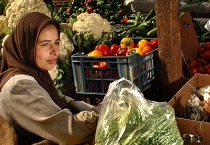Egypt

In Egypt, the WEPS project is implemented in collaboration with the Ministry of Water Resources and Irrigation and the Ministry of Agriculture, and is guided by the multidisciplinary team of the water scarcity initiative that gather key stakeholders interested in water issues (see country team and partners).
Background
Egypt lies in the north eastern corner of the African continent and has a total area of about one million km2. The majority of the country area is desert land. Most of the cultivated land is located close to the banks of the Nile River, its main branches and canals, and in the Nile Delta area. Range land is restricted to a narrow strip, only a few kilometers wide, along the Mediterranean coast and its bearing capacity is quite low. The total cultivated area (arable land plus permanent crops) is 3.8 million ha in 2013, or about four percent of the total area of the country. Agriculture, even though contributing only 14.5 percent to GDP compared to 30 percent in the 1960s, is still a major economic activity in Egypt, as it plays an important role for many people as sustenance farming. Nearly all agriculture depends on irrigation water (MWRI, 2005). In 2010, the total irrigated area covers 98 percent of the cultivated area. Even the small, more humid area along the Mediterranean coast requires water harvesting or supplementary irrigation to produce reasonable yields. Smallholdings characterize Egyptian agriculture, with about 50 percent of holdings having an area less than 0.42 ha (one feddan). Urbanization represents a serious threat to agriculture in Egypt. Rainfall is very limited mainly on the northern coast with an average 150 millimeter per year. The Nile River represents over 90 percent of the countries water resources. In 2010, total water withdrawal was estimated at 78 000 million m3, including 67 000 million m3 for agriculture (86 percent), 9 000 million m3 for municipalities (11.5 percent) and 2 000 million m3 for industries (2.5 percent). The country is water stressed with only 500 cubic meter renewable water resources per capita per year. To address this issue, since 1993, Egypt is implementing a national strategy for multiple reuse of agriculture drainage water with a complex system of sub-surface drainage system, and since 1993 an ambitious program of irrigation improvements to increase water productivity and aiming at water savings. Moreover, seawater desalination is taking a growing share of the urban water supply.
